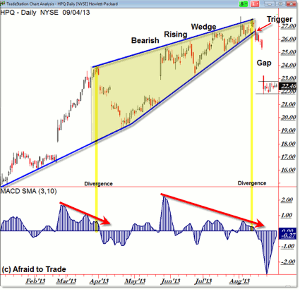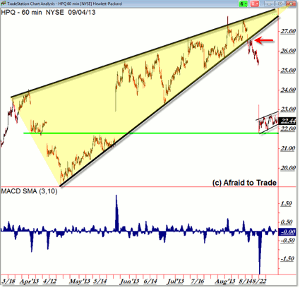This chart pattern is a bearish signal that indicates a reversal from an uptrend, and in a recent example, technician Corey Rosenbloom of AfraidToTrade.com details how traders can identify this pattern and act according to their trading styles.
For traders new to trading chart patterns, a textbook example of the bearish rising wedge pattern developed in textbook fashion, which can serve as an excellent real-world example for you.
Let’s take a moment to identify the bearish rising wedge pattern and how it played out perfectly in Hewlett-Packard (HPQ) shares.
Here’s the bigger picture on the daily chart:
When identifying stocks in bullish trends, one needs to be aware of hidden reversal signals or price patterns such as lengthy divergences and the ominous bearish rising wedge price compression pattern.
Assuming we don’t know the breakdown outcome, as late as August 13, we would see a strong stock rising in a lengthy uptrend into the $27.00 per share level.
Scratch beneath the surface and we see a lengthy negative momentum divergence that has been developing since the early June 2013 gap-up event.
We can see a similar, though less lengthy (one month) divergence developing then playing out into the April retracement.
Beyond the lengthy or “multi-swing momentum divergence,” savvy traders could also identify a trendline compression pattern where the lower support trendline was rising at a steeper rate than the upper resistance trendline (that’s key to identifying this pattern).
For reference, the point at which the trendlines cross is called the “apex” and the same logic holds for classic triangle price patterns.
The combination of the lengthy negative divergence with the compressing trendlines flashed a powerful “caution” signal and suggested that traders look elsewhere for bullish plays.
It signaled opportunity for very aggressive traders who enjoy playing breakout or reversal outcomes.
Note the large downside sell-day of August 15, which officially triggered a potential “breakout” trading signal.
The break under the rising trendline should trigger stop-losses from the buyers/bulls; in the same token, it signals entry for bears/short-sellers. This is the supply/demand dynamic that helps propel the rest of the move, which sets up the trade.
For bearish traders, the trigger occurs on a close under the trendline such as the move to $26.00 per share. The stop is naturally placed above the upper rising trendline or prior price which was intersecting $27.50 per share.
The outcome—or the target—for any type of reversal or breakout event is a large play or sudden impulse move.
Let’s step inside the hourly chart for a clearer perspective of the pattern development and outcome:
We can see the entirety of the price pattern from April to August and the initial stages of the breakdown from the bearish rising wedge pattern and trading opportunity (for aggressive traders).
On a breakdown, downside targets would include any of the 38.2%, 50.0%, 61.8% Fibonacci levels or any prior price low including the June swing low into $23.00 per share.
Fortunately for short-sellers, price continued to trade lower away from the breakout trendline ($26.50) then collapsed violently in a gap event on August 22.
Price then traded toward the $22.00 per share level and the mini-reference level from April and May (see green highlight).
At this point with the breakdown trade in a $4.00 swing trading profit, traders can determine whether to take full or partial profits at this initial level—expecting a potential bounce up—or else hold or re-enter for a possible new breakdown event under $22.00 per share…but that’s another story.
Continue studying the bearish rising wedge pattern—the logic is flipped for a bullish falling wedge reversal pattern—and use the recent example in HPQ as a great textbook case.
By Corey Rosenbloom, CMT, Trader and Blogger, AfraidToTrade.com























